Input interpretation

H_2SO_4 sulfuric acid + NaI sodium iodide ⟶ H_2O water + I_2 iodine + H_2S hydrogen sulfide + NaHSO_4 sodium bisulfate
Balanced equation
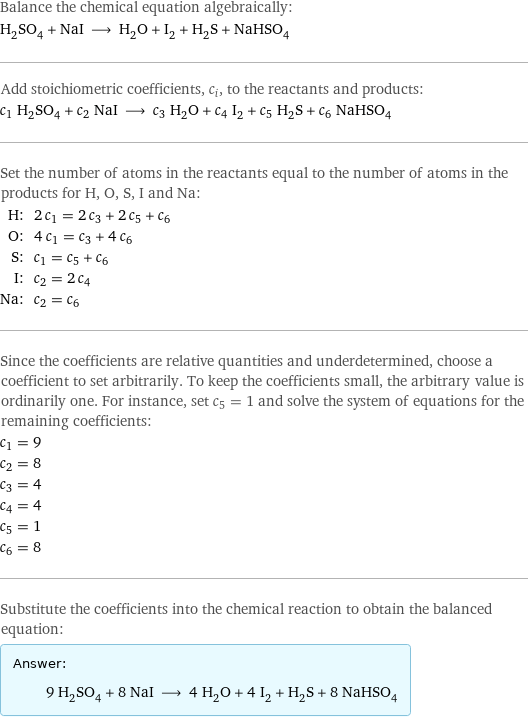
Balance the chemical equation algebraically: H_2SO_4 + NaI ⟶ H_2O + I_2 + H_2S + NaHSO_4 Add stoichiometric coefficients, c_i, to the reactants and products: c_1 H_2SO_4 + c_2 NaI ⟶ c_3 H_2O + c_4 I_2 + c_5 H_2S + c_6 NaHSO_4 Set the number of atoms in the reactants equal to the number of atoms in the products for H, O, S, I and Na: H: | 2 c_1 = 2 c_3 + 2 c_5 + c_6 O: | 4 c_1 = c_3 + 4 c_6 S: | c_1 = c_5 + c_6 I: | c_2 = 2 c_4 Na: | c_2 = c_6 Since the coefficients are relative quantities and underdetermined, choose a coefficient to set arbitrarily. To keep the coefficients small, the arbitrary value is ordinarily one. For instance, set c_5 = 1 and solve the system of equations for the remaining coefficients: c_1 = 9 c_2 = 8 c_3 = 4 c_4 = 4 c_5 = 1 c_6 = 8 Substitute the coefficients into the chemical reaction to obtain the balanced equation: Answer: | | 9 H_2SO_4 + 8 NaI ⟶ 4 H_2O + 4 I_2 + H_2S + 8 NaHSO_4
Structures

+ ⟶ + + +
Names

sulfuric acid + sodium iodide ⟶ water + iodine + hydrogen sulfide + sodium bisulfate
Reaction thermodynamics
Enthalpy
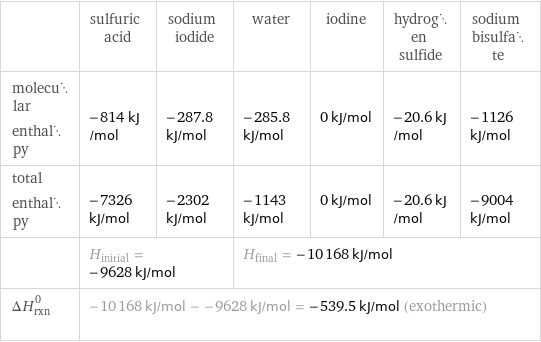
| sulfuric acid | sodium iodide | water | iodine | hydrogen sulfide | sodium bisulfate molecular enthalpy | -814 kJ/mol | -287.8 kJ/mol | -285.8 kJ/mol | 0 kJ/mol | -20.6 kJ/mol | -1126 kJ/mol total enthalpy | -7326 kJ/mol | -2302 kJ/mol | -1143 kJ/mol | 0 kJ/mol | -20.6 kJ/mol | -9004 kJ/mol | H_initial = -9628 kJ/mol | | H_final = -10168 kJ/mol | | | ΔH_rxn^0 | -10168 kJ/mol - -9628 kJ/mol = -539.5 kJ/mol (exothermic) | | | | |
Gibbs free energy
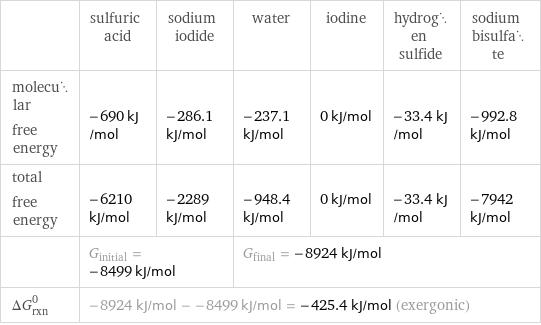
| sulfuric acid | sodium iodide | water | iodine | hydrogen sulfide | sodium bisulfate molecular free energy | -690 kJ/mol | -286.1 kJ/mol | -237.1 kJ/mol | 0 kJ/mol | -33.4 kJ/mol | -992.8 kJ/mol total free energy | -6210 kJ/mol | -2289 kJ/mol | -948.4 kJ/mol | 0 kJ/mol | -33.4 kJ/mol | -7942 kJ/mol | G_initial = -8499 kJ/mol | | G_final = -8924 kJ/mol | | | ΔG_rxn^0 | -8924 kJ/mol - -8499 kJ/mol = -425.4 kJ/mol (exergonic) | | | | |
Equilibrium constant
![Construct the equilibrium constant, K, expression for: H_2SO_4 + NaI ⟶ H_2O + I_2 + H_2S + NaHSO_4 Plan: • Balance the chemical equation. • Determine the stoichiometric numbers. • Assemble the activity expression for each chemical species. • Use the activity expressions to build the equilibrium constant expression. Write the balanced chemical equation: 9 H_2SO_4 + 8 NaI ⟶ 4 H_2O + 4 I_2 + H_2S + 8 NaHSO_4 Assign stoichiometric numbers, ν_i, using the stoichiometric coefficients, c_i, from the balanced chemical equation in the following manner: ν_i = -c_i for reactants and ν_i = c_i for products: chemical species | c_i | ν_i H_2SO_4 | 9 | -9 NaI | 8 | -8 H_2O | 4 | 4 I_2 | 4 | 4 H_2S | 1 | 1 NaHSO_4 | 8 | 8 Assemble the activity expressions accounting for the state of matter and ν_i: chemical species | c_i | ν_i | activity expression H_2SO_4 | 9 | -9 | ([H2SO4])^(-9) NaI | 8 | -8 | ([NaI])^(-8) H_2O | 4 | 4 | ([H2O])^4 I_2 | 4 | 4 | ([I2])^4 H_2S | 1 | 1 | [H2S] NaHSO_4 | 8 | 8 | ([NaHSO4])^8 The equilibrium constant symbol in the concentration basis is: K_c Mulitply the activity expressions to arrive at the K_c expression: Answer: | | K_c = ([H2SO4])^(-9) ([NaI])^(-8) ([H2O])^4 ([I2])^4 [H2S] ([NaHSO4])^8 = (([H2O])^4 ([I2])^4 [H2S] ([NaHSO4])^8)/(([H2SO4])^9 ([NaI])^8)](../image_source/b31983add8f5efb8fa20a46f2617a829.png)
Construct the equilibrium constant, K, expression for: H_2SO_4 + NaI ⟶ H_2O + I_2 + H_2S + NaHSO_4 Plan: • Balance the chemical equation. • Determine the stoichiometric numbers. • Assemble the activity expression for each chemical species. • Use the activity expressions to build the equilibrium constant expression. Write the balanced chemical equation: 9 H_2SO_4 + 8 NaI ⟶ 4 H_2O + 4 I_2 + H_2S + 8 NaHSO_4 Assign stoichiometric numbers, ν_i, using the stoichiometric coefficients, c_i, from the balanced chemical equation in the following manner: ν_i = -c_i for reactants and ν_i = c_i for products: chemical species | c_i | ν_i H_2SO_4 | 9 | -9 NaI | 8 | -8 H_2O | 4 | 4 I_2 | 4 | 4 H_2S | 1 | 1 NaHSO_4 | 8 | 8 Assemble the activity expressions accounting for the state of matter and ν_i: chemical species | c_i | ν_i | activity expression H_2SO_4 | 9 | -9 | ([H2SO4])^(-9) NaI | 8 | -8 | ([NaI])^(-8) H_2O | 4 | 4 | ([H2O])^4 I_2 | 4 | 4 | ([I2])^4 H_2S | 1 | 1 | [H2S] NaHSO_4 | 8 | 8 | ([NaHSO4])^8 The equilibrium constant symbol in the concentration basis is: K_c Mulitply the activity expressions to arrive at the K_c expression: Answer: | | K_c = ([H2SO4])^(-9) ([NaI])^(-8) ([H2O])^4 ([I2])^4 [H2S] ([NaHSO4])^8 = (([H2O])^4 ([I2])^4 [H2S] ([NaHSO4])^8)/(([H2SO4])^9 ([NaI])^8)
Rate of reaction
![Construct the rate of reaction expression for: H_2SO_4 + NaI ⟶ H_2O + I_2 + H_2S + NaHSO_4 Plan: • Balance the chemical equation. • Determine the stoichiometric numbers. • Assemble the rate term for each chemical species. • Write the rate of reaction expression. Write the balanced chemical equation: 9 H_2SO_4 + 8 NaI ⟶ 4 H_2O + 4 I_2 + H_2S + 8 NaHSO_4 Assign stoichiometric numbers, ν_i, using the stoichiometric coefficients, c_i, from the balanced chemical equation in the following manner: ν_i = -c_i for reactants and ν_i = c_i for products: chemical species | c_i | ν_i H_2SO_4 | 9 | -9 NaI | 8 | -8 H_2O | 4 | 4 I_2 | 4 | 4 H_2S | 1 | 1 NaHSO_4 | 8 | 8 The rate term for each chemical species, B_i, is 1/ν_i(Δ[B_i])/(Δt) where [B_i] is the amount concentration and t is time: chemical species | c_i | ν_i | rate term H_2SO_4 | 9 | -9 | -1/9 (Δ[H2SO4])/(Δt) NaI | 8 | -8 | -1/8 (Δ[NaI])/(Δt) H_2O | 4 | 4 | 1/4 (Δ[H2O])/(Δt) I_2 | 4 | 4 | 1/4 (Δ[I2])/(Δt) H_2S | 1 | 1 | (Δ[H2S])/(Δt) NaHSO_4 | 8 | 8 | 1/8 (Δ[NaHSO4])/(Δt) (for infinitesimal rate of change, replace Δ with d) Set the rate terms equal to each other to arrive at the rate expression: Answer: | | rate = -1/9 (Δ[H2SO4])/(Δt) = -1/8 (Δ[NaI])/(Δt) = 1/4 (Δ[H2O])/(Δt) = 1/4 (Δ[I2])/(Δt) = (Δ[H2S])/(Δt) = 1/8 (Δ[NaHSO4])/(Δt) (assuming constant volume and no accumulation of intermediates or side products)](../image_source/46f49b550c38fc4f78bca45faaefb98e.png)
Construct the rate of reaction expression for: H_2SO_4 + NaI ⟶ H_2O + I_2 + H_2S + NaHSO_4 Plan: • Balance the chemical equation. • Determine the stoichiometric numbers. • Assemble the rate term for each chemical species. • Write the rate of reaction expression. Write the balanced chemical equation: 9 H_2SO_4 + 8 NaI ⟶ 4 H_2O + 4 I_2 + H_2S + 8 NaHSO_4 Assign stoichiometric numbers, ν_i, using the stoichiometric coefficients, c_i, from the balanced chemical equation in the following manner: ν_i = -c_i for reactants and ν_i = c_i for products: chemical species | c_i | ν_i H_2SO_4 | 9 | -9 NaI | 8 | -8 H_2O | 4 | 4 I_2 | 4 | 4 H_2S | 1 | 1 NaHSO_4 | 8 | 8 The rate term for each chemical species, B_i, is 1/ν_i(Δ[B_i])/(Δt) where [B_i] is the amount concentration and t is time: chemical species | c_i | ν_i | rate term H_2SO_4 | 9 | -9 | -1/9 (Δ[H2SO4])/(Δt) NaI | 8 | -8 | -1/8 (Δ[NaI])/(Δt) H_2O | 4 | 4 | 1/4 (Δ[H2O])/(Δt) I_2 | 4 | 4 | 1/4 (Δ[I2])/(Δt) H_2S | 1 | 1 | (Δ[H2S])/(Δt) NaHSO_4 | 8 | 8 | 1/8 (Δ[NaHSO4])/(Δt) (for infinitesimal rate of change, replace Δ with d) Set the rate terms equal to each other to arrive at the rate expression: Answer: | | rate = -1/9 (Δ[H2SO4])/(Δt) = -1/8 (Δ[NaI])/(Δt) = 1/4 (Δ[H2O])/(Δt) = 1/4 (Δ[I2])/(Δt) = (Δ[H2S])/(Δt) = 1/8 (Δ[NaHSO4])/(Δt) (assuming constant volume and no accumulation of intermediates or side products)
Chemical names and formulas
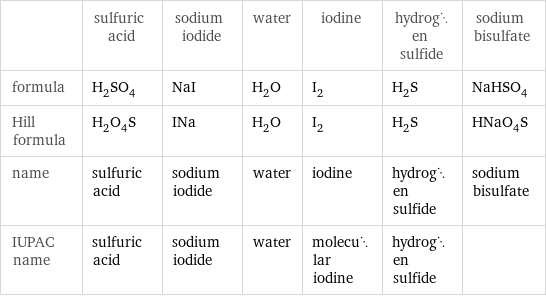
| sulfuric acid | sodium iodide | water | iodine | hydrogen sulfide | sodium bisulfate formula | H_2SO_4 | NaI | H_2O | I_2 | H_2S | NaHSO_4 Hill formula | H_2O_4S | INa | H_2O | I_2 | H_2S | HNaO_4S name | sulfuric acid | sodium iodide | water | iodine | hydrogen sulfide | sodium bisulfate IUPAC name | sulfuric acid | sodium iodide | water | molecular iodine | hydrogen sulfide |
Substance properties
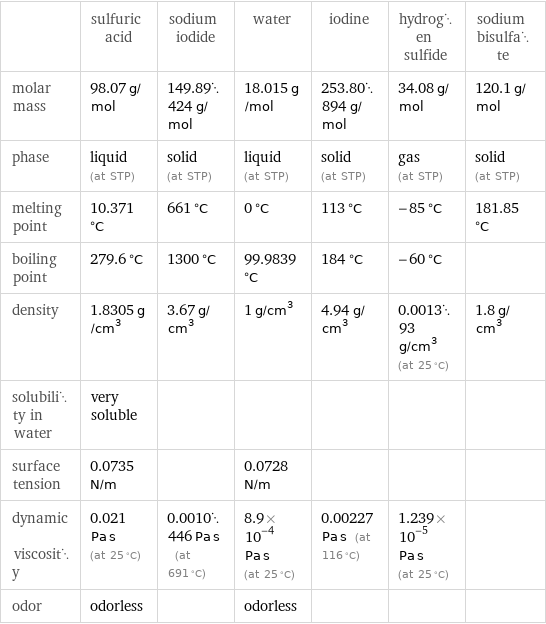
| sulfuric acid | sodium iodide | water | iodine | hydrogen sulfide | sodium bisulfate molar mass | 98.07 g/mol | 149.89424 g/mol | 18.015 g/mol | 253.80894 g/mol | 34.08 g/mol | 120.1 g/mol phase | liquid (at STP) | solid (at STP) | liquid (at STP) | solid (at STP) | gas (at STP) | solid (at STP) melting point | 10.371 °C | 661 °C | 0 °C | 113 °C | -85 °C | 181.85 °C boiling point | 279.6 °C | 1300 °C | 99.9839 °C | 184 °C | -60 °C | density | 1.8305 g/cm^3 | 3.67 g/cm^3 | 1 g/cm^3 | 4.94 g/cm^3 | 0.001393 g/cm^3 (at 25 °C) | 1.8 g/cm^3 solubility in water | very soluble | | | | | surface tension | 0.0735 N/m | | 0.0728 N/m | | | dynamic viscosity | 0.021 Pa s (at 25 °C) | 0.0010446 Pa s (at 691 °C) | 8.9×10^-4 Pa s (at 25 °C) | 0.00227 Pa s (at 116 °C) | 1.239×10^-5 Pa s (at 25 °C) | odor | odorless | | odorless | | |
Units
